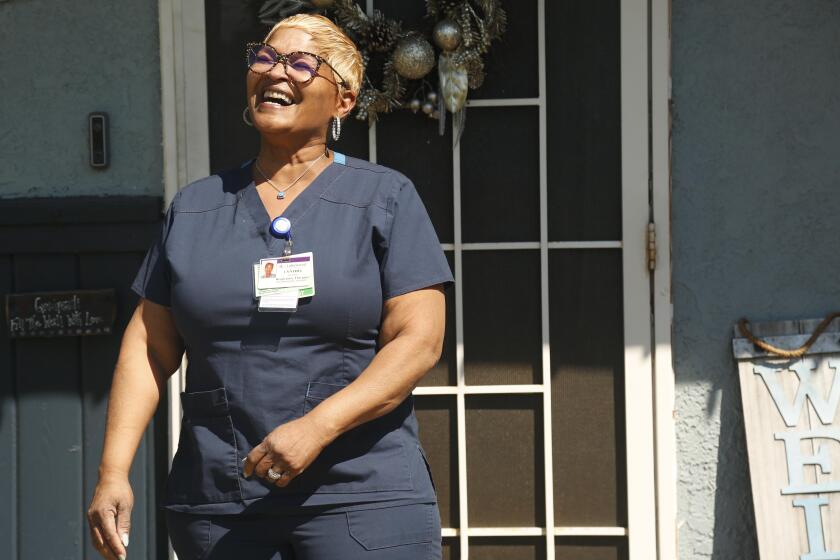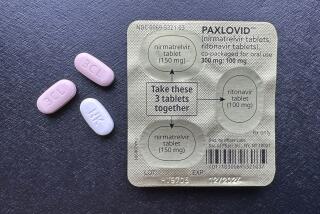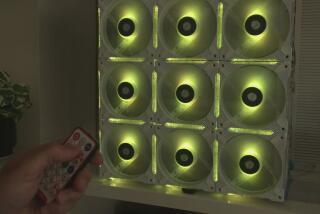With ventilators in short supply, here are some alternatives
With the coronavirus still spreading and cases of COVID-19 still mounting, mechanical ventilators are in notoriously short supply. That has physicians scrambling to find alternatives for patients so weakened by the respiratory disease that they can no longer breathe without assistance.
It won’t be easy.
The modern mechanical ventilator has been a workhorse in hospital intensive care units since the 1950s, when better breathing assistance was needed for the most stricken polio patients. The machines mimic the act of breathing by pushing oxygen-rich air into the lungs and removing carbon dioxide through a separate tube.
They save lives, but they’re tough medicine. To tolerate such an invasive takeover of normal respiration, a patient must be put into a coma-like state with anesthesia drugs. She cannot speak, move around or eat on her own. And she has a foreign object running into her body’s central air exchange system, potentially inflaming that delicate tissue and introducing dangerous new microbes.
Then there is the tricky business of weaning a patient off a ventilator, which can take a full week. The procedure is fraught with perils, especially if undertaken too early, too quickly or too late.
Yet for all its drawbacks, mechanical ventilation has become the standard of care for people with acute respiratory failure or seriously compromised lung function. In normal times, more than half of patients admitted to an ICU are put on ventilators within 24 hours.
“You never want to be playing catch-up with someone who can’t breathe,” said Dr. Megan Coffee, an infectious disease specialist at NYU.
Several groups of researchers are testing different methods to divert critically ill COVID-19 patients from needing ventilators in the first place.
But in some hospitals, “never” has arrived. To treat a torrent of COVID-19 patients with a limited number of ventilators, doctors will be forced “to MacGyver it,” said Dr. John P Kress, an intensive care physician at the University of Chicago.
Here’s a look at what they’ll try.
Bilevel positive airway pressure
Referred to by doctors as “noninvasive BiPap,” this device is ordinarily used to help patients whose breathing problems have not progressed to the critical stage. It relies on a type of ventilator that can deliver oxygen under pressure, but typically has less monitoring capability than the full-fledged ventilators now in such scarce supply.
With a BiPap machine, a pressurized flow of oxygen-rich air is delivered through a mask that fits tightly to a patient’s face. The treatment can help keep the lungs’ tiniest compartments from filling with fluid and ensure that oxygen is delivered to the blood while the patient remains conscious and able to move, talk and eat — all of which may speed healing.
In ordinary times, doctors will reach for a BiPap “to buy time” for treatments like steroids or antibiotics to work, and for a patient’s lungs to begin healing themselves, said Dr. Mark Hepokoski a critical care specialist at UC San Diego. Its wider use in COVID-19 patients might increase the supply of assistive breathing devices by 10% to 15%, he added.
Inhaled nitric oxide appeared to kill the coronavirus that caused severe acute respiratory syndrome, or SARS, and it might work on COVID-19 as well.
But the BiPap’s benefits for patients are a source of peril for those caring for them. The patient can take off the mask to cough or sneeze, and many want to loosen or remove the mask when the high pressure of its airflow becomes uncomfortable.
That does more than compromise treatment, experts said. In a patient whose respiratory secretions are teeming with the coronavirus, it poses threats to doctors, nurses and respiratory therapists, many of whom are running short of personal protection equipment.
BiPap machines could be used to wean some improving patients off mechanical ventilators, freeing up the machines for incoming patients, said Dr. Atul Malhotra, a lung specialist at UC San Diego. But as caregivers remove virus-laden tubes from the lungs of patients who are still sick, they again will need strong protection.
“Protecting healthcare providers is paramount, because if we lose that battle we lose the war,” said Malhotra.
Anesthesia machines
The machines that pump anesthesia into the lungs of patients during surgical procedures could provide mechanical ventilation to COVID-19 patients who have developed respiratory distress. They are a step up from BiPap devices because they allow for more monitoring.
“With the change of a single vent,” an anesthesia machine can be converted to “a very useful ventilator,” Vice President Mike Pence said at a White House coronavirus task force briefing last month. “We literally believe there are tens of thousands of ventilators that can be converted now.”
Anesthesia machines have largely been freed up by the widespread pause in elective and outpatient surgeries. The American Society of Anesthesiologists estimates that roughly 70,000 such machines are available in hospitals and ambulatory care centers across the country. The ASA and the Food and Drug Administration have issued step-by-step instructions for converting them for use with COVID-19 patients.
Ventilator sharing
While far from ideal, the sharing of ventilators by more than one patient is “a possible crisis standard of care strategy currently contemplated by several [medical] centers,” Surgeon Gen. Jerome Adams and the Health and Human Services Department Assistant Secretary of Health Brett Giroir wrote in a March 31 statement to healthcare providers.
The federal government won’t bar the practice, the two physicians wrote. But, they added, “such a strategy should only be considered as an absolute last resort.”
They warned that patients sharing a single mechanical ventilator might infect each other with bacteria and viruses. And they cautioned that doctors could not carefully calibrate the pressure at which oxygen is delivered by a ventilator when more than one patient is on it.
As states scramble to secure ventilators during the crisis, a potential shortage looms of respiratory therapists, the workers trained to operate them.
For some patients, lung damage could result if oxygen is delivered under too much pressure. On the other hand, patients sharing a ventilator designed for one person could die from getting too little oxygen.
And if one patient on a shared ventilator should go into cardiac arrest, the ventilation of anyone else sharing the device would have to be stopped so the heart attack victim’s breathing tube could be removed and resuscitation efforts begun.
In late March, New York Gov. Andrew Cuomo approved the sharing of ventilators among more than one patient. “It’s not ideal,” he said, but “we have no alternative.”
Helmet-based ventilation
Kress and his colleagues have tested a less invasive way to deliver pressurized oxygen to patients in acute respiratory distress: a helmet that resembles an overturned fishbowl, sealed by a rubber collar and clamped down on a patient’s shoulders by a pair of underarm straps.
Helmet-based ventilation would allow a patient to stay awake and speak to loved ones while receiving breathing assistance. The tubes feeding the helmet could be plugged into the “medical air” supply in the wall behind virtually any standard hospital bed.
Dr. Colleen Kraft was part of the Emory University team that successfully cared for America’s first Ebola patients. She now is a cool-headed stalwart who is soothing nerves during the coronavirus pandemic.
Kress and his team, who published their report on the device in the Journal of the American Medical Assn. in 2008, hoped it would at least delay patients’ need for full-on invasive mechanical ventilation. The trial suggested that patients who got helmet-assisted ventilation ended up spending less time breathing through a tube — and 30% avoided intubation altogether. Overall, they were less likely to die than those treated first with noninvasive BiPap.
The helmet-based ventilation has been widely used — and is still used today — in Italy, France and Spain, Kress said. “But the equipment just never took off here like it did in Europe,” he said.
Many large medical centers have a few helmets tucked away, and they could be adapted for use on COVID-19 patients. “It could make an impact,” Kress said.
The helmets may yet catch on. Sea-Long Inc., the only U.S. company that currently produces the helmets, is now able to make about 100 a week. Chris Austin, Sea-Long’s president, said the company had received an injection of capital to scale up its production. In short order, the Waxahachie, Texas-based company will be able to make 5,000 helmets a week, he said.
Hemolung
Distressed lungs do a poor job of removing carbon dioxide, which builds in the blood up with toxic results. The Hemolung system is like a dialysis machine for the lungs, removing carbon dioxide from the blood.
That could keep COVID-19 patients who get sick enough to develop acute respiratory distress syndrome, or ARDS, off mechanical ventilation — or at least delay that outcome. Or it could allow doctors to use less-intense mechanical ventilation on these patients, sparing their lungs some trauma.
The Hemolung was devised for patients with emphysema and ARDS and is currently in clinical trials in the United Kingdom and at 34 sites in the United States.
University of Pittsburgh bioengineer William Federspiel invented the Hemolung and co-founded ALung Technologies Inc., which is seeking FDA clearance to market the device in the United States. He has sought “emergency use authorization” to allow the Hemolung to be used for COVID-19 patients.








